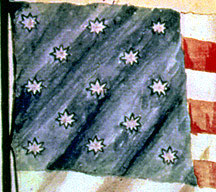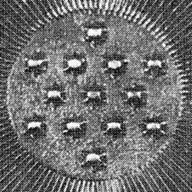In September 1782, three months after Congress adopted the Great Seal in the form of a written description, the first die was created. It was engraved by Robert Scot who arranged the constellation of 13 stars into the shape of a hexagram – two intersecting triangles that form a six-pointed star.
Putting the stars in a recognizable pattern not specified in the Great Seal's official design description – whether a hexagram, a dollar sign, a heart, or other image – is contrary to the rules of heraldry. Unfortunately, this engraver's error was repeated in all subsequent dies of the Great Seal and government realizations.
It's not known why Scot chose the hexagram shape, and there's been much speculation about its symbolism, but he may have merely rearranged a few stars on the American flag.


Stars on the flag and stars on the seal
The flag's 13 stars were in five rows (3,2,3,2,3) on a rectangular field. For the Great Seal, they needed to fit inside a circular field. This is easily done by moving the top corner stars down a row and the bottom corner stars up a row.

